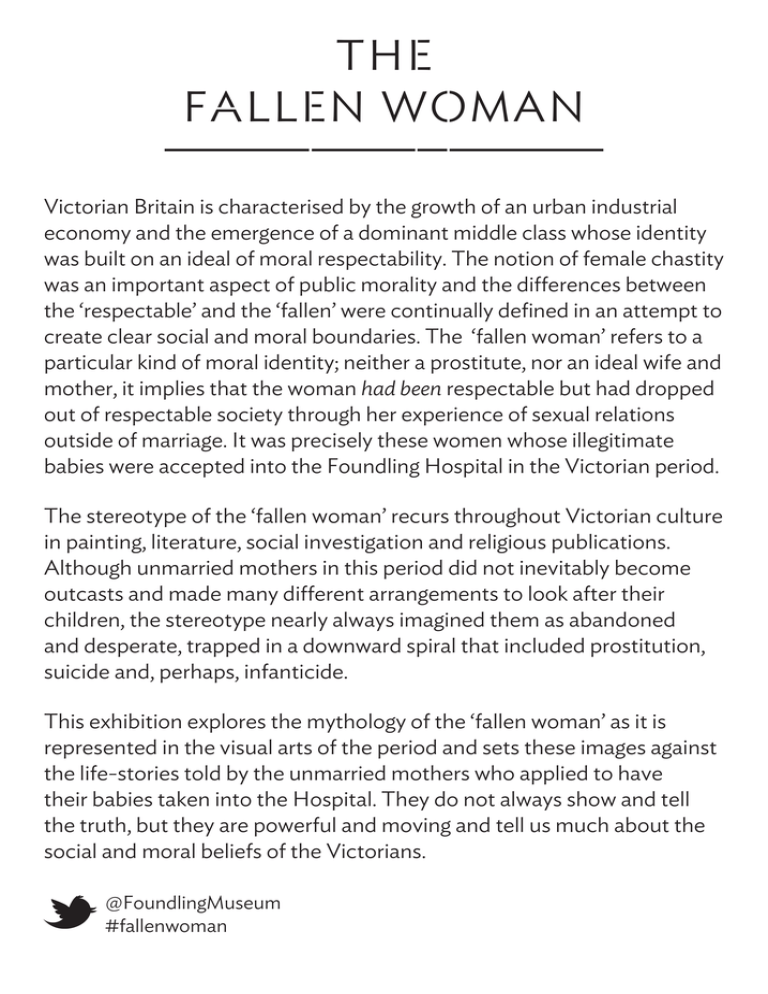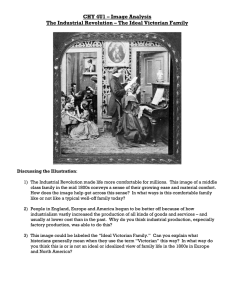
THE
FALLEN WOMAN
Victorian Britain is characterised by the growth of an urban industrial
economy and the emergence of a dominant middle class whose identity
was built on an ideal of moral respectability. The notion of female chastity
was an important aspect of public morality and the differences between
the ‘respectable’ and the ‘fallen’ were continually defined in an attempt to
create clear social and moral boundaries. The ‘fallen woman’ refers to a
particular kind of moral identity; neither a prostitute, nor an ideal wife and
mother, it implies that the woman had been respectable but had dropped
out of respectable society through her experience of sexual relations
outside of marriage. It was precisely these women whose illegitimate
babies were accepted into the Foundling Hospital in the Victorian period.
The stereotype of the ‘fallen woman’ recurs throughout Victorian culture
in painting, literature, social investigation and religious publications.
Although unmarried mothers in this period did not inevitably become
outcasts and made many different arrangements to look after their
children, the stereotype nearly always imagined them as abandoned
and desperate, trapped in a downward spiral that included prostitution,
suicide and, perhaps, infanticide.
This exhibition explores the mythology of the ‘fallen woman’ as it is
represented in the visual arts of the period and sets these images against
the life-stories told by the unmarried mothers who applied to have
their babies taken into the Hospital. They do not always show and tell
the truth, but they are powerful and moving and tell us much about the
social and moral beliefs of the Victorians.
@FoundlingMuseum
#fallenwoman
A
VICTORIAN IDEAL
The roles of the ideal Victorian woman were summed up through the
notion of ‘woman’s mission’, as loyal wife, adoring mother and dutiful
daughter. These roles were seen to carry great moral responsibility as
the woman was regarded as the guardian of the home and of domestic
and social order. Motherhood was considered the most valuable and
natural component of a woman’s mission; it was her greatest purpose
in life and her chief source of pleasure. At the same time, a number of
painters began to celebrate the Victorian ideal of motherhood in small
genre pictures showing mothers and babies as an updated and everyday
version of the ‘Madonna and Child’.
During the first half of the nineteenth century the distinctions between
the married and the unmarried were more sharply drawn. In 1836 the
Marriage Act extended the definition of legal marriage to include civil
ceremonies held in register offices, thus reinforcing the differences
between the respectable and the non-respectable. This made the figure
of the unmarried mother especially deviant and anti-social. Not only had
she lost her feminine purity by having extra-marital sexual relationships,
she had also abandoned her woman’s mission as homemaker and
obedient and companionable wife.
The figure of the ‘fallen woman’ thus challenged the social, moral and
sexual norms of Victorian society and threatened the image of the happy
family home which was regarded as the secure base for both the nation
and the empire.
FALLS
The cause of a woman’s fall from virtue was the key element of the story
of the fallen woman both in Victorian art and in social investigations such
as those of the Foundling Hospital. While some writers acknowledged
that extreme poverty might make marriage less relevant to the lives of
the poorer in society, others suggested that women fell for a variety of
other social and moral reasons.
Vanity and laziness were believed to make some young women more
vulnerable to seduction, and employment outside the home on the
streets of the city was also believed to expose women to greater risk of
‘temptation’. The life-stories told by the women who submitted petitions
to the Foundling Hospital also show many incidents of violent sexual
assault by men both known and unknown to them. What is almost
impossible to uncover in nineteenth-century sources is female sexual
desire; women could never have admitted this in official documents and
it could never have been shown in mainstream Victorian culture.
CONSEQUENCES
The conventional narrative of the fallen woman and of unmarried
mothers was of downfall and decline. Cast out by society and by
their families, they are exposed to the harshest extremes of society
and, maddened by shame, they are forced to abandon their babies
and even to consider suicide and infanticide. It was too easy, in these
circumstances, for the fallen woman to turn to prostitution as a solution
to her economic need and in order to maintain her baby. Within this
conservative set of beliefs, once a woman had fallen from virtue there
was little chance of escape from an inevitable decline into prostitution,
disease and death. While some doctors suggested that very few women
who became prostitutes would survive more than two or three years,
artists and writers turned to the tragic end of the fallen woman as a
powerful and dramatic subject from modern life that would move their
audiences and attract public attention to their work.
Clearly the mythology of the fallen woman did not describe the actual
experiences of all women in the nineteenth century. Some unmarried
mothers would have been supported by their families and might later
have married. This is sometimes the case of the women who applied
to the Foundling Hospital. There were also a number of ‘rescue’
organisations that worked specifically with fallen women, along with
orphanages or workhouses that would take abandoned children. These
were appalling choices for the women concerned and the Foundling
Hospital, with its reputation for kindness and care, would have been
greatly preferable in this situation.
THE
FOUNDLING HOSPITAL
During the nineteenth century the Foundling Hospital changed its
admission procedures to focus on restoring respectability to the mothers
of illegitimate children. Only the appeals of women who could prove
they were previously honest, sober and industrious were considered.
Admission procedures became more structured and women – known as
petitioners – had to negotiate a rigorous selection process before their
child was admitted.
To apply, a woman had to complete a petition form and then come for
an interview with a panel of male Governors. They questioned her on
the information she had provided, her background, how she became
pregnant and what she knew of the father’s current whereabouts. The
contents of the interview were recorded in the petitioner’s statement.
The Hospital’s Enquirer subsequently investigated the woman’s story
to ensure its truthfulness and request references. On this evidence, the
Governors made a decision as to whether the petitioner’s child could be
accepted. Sometimes shocking in their content, the petitions and related
documents contain a wealth of information about the experiences of
women considered by contemporaries to be ‘fallen’.
THE
FALLEN WOMAN
Victorian Britain is characterised by the growth of an urban industrial
economy and the emergence of a powerful and dominant middle
class whose identity was built on an ideal of moral respectability. The
notion of female chastity was an important aspect of public morality
and throughout the nineteenth century the differences between the
‘respectable’ and the ‘fallen’ were continually defined in an attempt to
create clear social and moral boundaries. The ‘fallen woman’ refers to
a particular kind of moral identity; neither a prostitute, nor an ideal wife
and mother, it implies that the woman had been respectable but had
dropped out of respectable society through her experience of sex outside
of marriage. It was precisely these women whose illegitimate babies were
accepted into the Foundling Hospital in the Victorian period.
This room shows how artists and writers depicted the possible
consequences for unmarried mothers in the Victorian period.
THE FALLEN WOMAN main exhibition gallery is on the lower ground floor.



